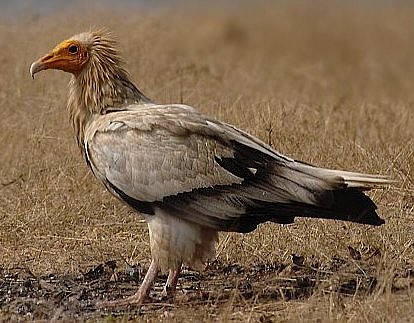
The Medi Ambient (Environment Agency) of Lleida has recently published a draft proposal detailing measures aimed at protecting certain species of flora and fauna on some of the most important cliffs of western Catalunya. If fully implemented, these measures would severely limit activity in what is generally regarded one of the finest climbing locations in Europe.
The proposals concentrate on an area about 150 — 200 kilometres northwest of Barcelona, in the districts of La Noguera and Alt Urgell, and if these names are not especially familiar to most UK climbers, then perhaps those of some of the cliffs there are: Terradets, Vilanova de Meià, Camarasa and Santa Linya, to name just a few.
In essence, the proposal covers 6 species of birds of prey:
- Griffin Vulture (Gyps fulvus)
- Bearded Vulture (Gypaetus barbatus)
- Egyptian Vulture (Neophron percnopterus)
- Golden Eagle (Aquila chrysaetos)
- Bonelli's Eagle (Hieraaetus fasciatus)
- Peregrine Falcon (Falco peregrinus).
And two species of plant:
- Delphinium bolosii
- Petrocoptis montsicciana.
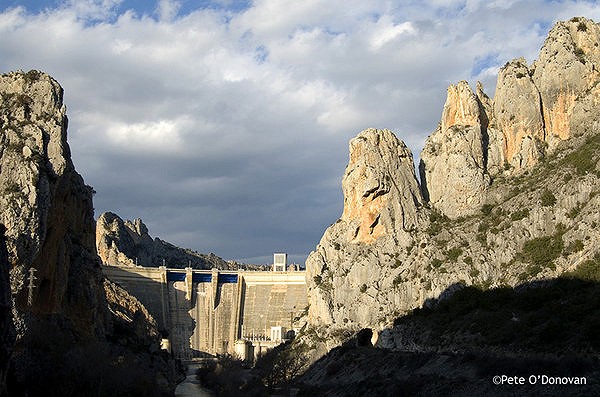
In the case of the two Eagles and
Peregrine Falcon, the proposed restrictions would limit climbing to a
period outside the nesting season (1st July —14th
January). On cliffs where any of the three species of Vulture nest,
the climbing ban would be TOTAL. On cliffs where either of the two
plant species is known to exist, the climbing ban would be TOTAL.
In addition, the development of new cliffs, together with the establishment of new routes in existing areas, would be severely limited and need to be 'vetted' first by the authorities. Furthermore, signs informing climbers of the restrictions would be placed on all approach roads and paths, and even stuck to the rock at the base of routes, just so there is no possible confusion about which climbs are affected.
A Personal View - Pete O'Donovan
I've been climbing on a regular basis in Catalunya, especially the western part, for 20 years, and have come to feel a real bond with the place. It's not just the climbing (although areas like Terradets and Vilanova de Meià undoubtedly offer some of the best limestone-sport action you'll find anywhere) but the landscape and wildlife too. In recent years the fame of its cliffs has spread far and wide, and there are many more visitors to the area now than when I first started climbing there. On the face of it (and I'm pretty sure this is what the environment folk think) the increased numbers of climbers could certainly be said to impact on bird species sharing the same space, especially the larger birds of prey, which typically require plenty of space.
However, this to me is too simplistic a view. The reality
is that western Catalunya is a BIG landscape, much of it desolate,
with deep gorges and enormous limestone cliffs stretching (often) as
far as the eye can see. At present, the amount of rock actually
climbed on is tiny as a proportion of the whole, and nearly always
the most easily accessible, i.e. closest to roads. Strange then that
shy, retiring creatures such as Eagles and Hawks should choose to
nest on the cliffs nearest human disturbance (traffic noise), when
they have kilometres of untouched rock walls in far more secluded
locations, whose isolated position makes them utterly impractical as
projects for climbing development. A good example of this is the
gorge of Camarasa, an area long popular with local climbers due to
its proximity to the major city of the area, Lleida, but now
increasingly visited by enthusiasts from further afield. Although the
gorge is deep, the cliffs themselves are not high — about 30
metres, maximum — and spread across the lower slopes on the north
side of the gorge, just above the river Segre. There's a busy main
road (C13) on the other side, an impressive feat of engineering cut
into the rock about 50 metres above the river, disappearing into a
tunnel before traversing a huge dam and skirting a vast reservoir
(Panta de Camarasa). On a normal day, traffic noise competes with the
roar of water as it passes through though Hydro electric plant
situated below the dam. All in all, not the quietest of places!
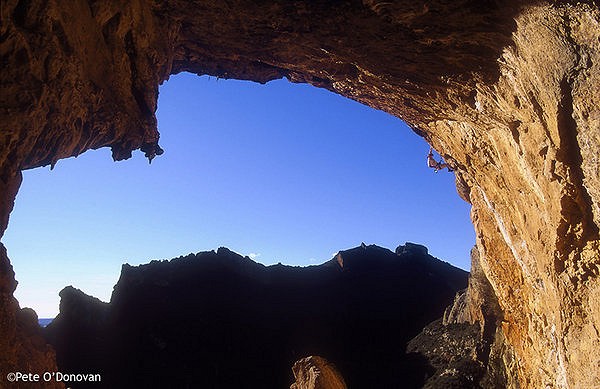
The
climbing is concentrated in an area of about one kilometre, and
accessed by a small road, which runs along the north side of the
river, dead-ending at the HE plant. Beyond the plant the walls
continue on the north side of the gorge for some 5 kilometres, as far
as the village of Alòs de Balaguer, but because the river
level was artificially raised many years ago, access to the base of
the cliffs is impossible, and they've never been developed. In
other words, there is a 5 km stretch of gorge with NO climbing. There
are also bands of higher, looser, less accessible rock above the main
climbing area. And there are literally acres of untouched rock
on the sunnier south side of the gorge, again a little loose and of
limited interest to the climber (although there are a couple of old
mixed/trad routes somewhere up there). But, despite this apparent
richness of habitat, the authorities say the birds want to nest on
the little bit we climb on and propose to place a year-round
ban, not only (they say) for the protection of the birds, but also to
promote the growth of the aforementioned plant species.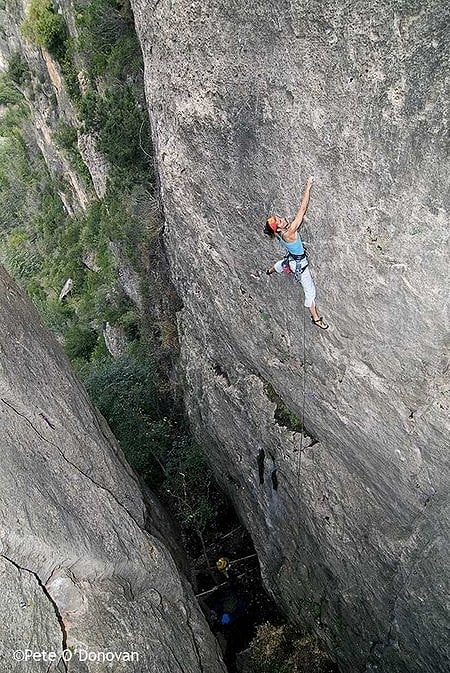
A similar case could be put for the amazing Paret de les Bruixes at Terradets, acknowledged as one of the finest single sport crags in the world, and scene of cutting edge activity by the likes of Dani Andrada, Patxi Usobiaga and our own Steve McClure. The angle of the rock here ranges from slightly, to very, overhanging — fine for extreme climbers and nesting Crag Martens (and they still come every year, despite the presence of climbers) but an impossible habitat for the big raptors. And, like Camarasa, the climbing here is concentrated in a very small area, on the lowest (and closest to the road) of several extensive rock bands marching up and away across the hillside. Once again, the proposed ban here is TOTAL. Further along, in the main gorge of Terradets, the 'big walls' of Paret de les Bagasses and Roca Regina, host to some of the finest multi-pitch routes in Spain, would be lost for six months of the year, as would the nearby (and equally fantastic) Vilanova de Meià.
At this point I should state that, like
many climbers, both here and in Spain, I fully support sensible
measures for the protection of wildlife — particularly birds of
prey, but my experiences on the cliffs of Catalunya over 20 years
does not lead me to believe that what I do for a hobby constitutes a
major threat to their continued existence!
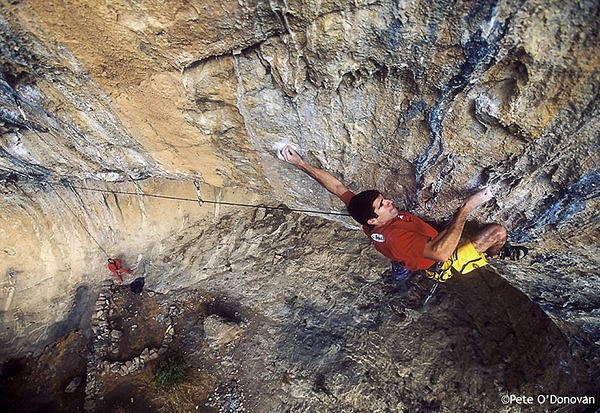
The species highlighted in the proposal
are a varied bunch of critters. The two eagles, Golden and Bonelli's
are, to be honest, pretty rare sights, though in my experience
commoner further south, in the Costa Daurada area (Siurana, Montsant,
etc.). The Environment agency says numbers of these two species have
declined in La Noguera and Alt Urgell; I'm not in a position to
argue with that. Vultures are another matter entirely, certainly as
far as Gyps fulvus is concerned. Although officially still
classified as 'threatened' in Catalunya, anyone who has recently
travelled through the north and west of the region, either by car or
on foot, should be able to testify to the fact that these giants of
the sky are doing very nicely, thankyou. Earlier this summer, while
climbing in the gorge of Oliana, I counted upwards of 30 soaring on
the thermals above me, just in one small area (perhaps I was moving
too slowly!) as well as many more perched on ledges on nearby walls,
and 'flocks' of this size are by no means unusual across the
region. In many areas their numbers seem almost inexplicable; how can
so many big birds find enough dead animals to survive, let alone
thrive? It's not even as if they die young, the oldest reaching 40
years! Apparently, on the French side of the Pyrenees, where these
birds are also doing well, farmers used to leave dead livestock out
in the fields, thus saving themselves the trouble and expense of
disposal, as well as doing the Vultures a favour at the same time,
but the practice was outlawed by the EU in 2002 after mad cow disease
reared its ugly head. So what do they eat now? Somehow, somewhere,
there must be an awful lot of less than sure-footed mountain goats
roaming the hillsides. The menu probably also includes the Isard
(Spanish Chamois), oh and also wild boar, which apparently are
getting way out of control after cross-breeding with domestic pigs
and consequently having larger litters. In other words; not a bad
time to be a scavenger, particularly one with good eyesight. Red
Kites, also appear to be doing very well in the area. Don't get me
wrong, I love to see these magnificent creatures, but I fail to see
the need to extend them further protection when they look to be
managing perfectly well on their own.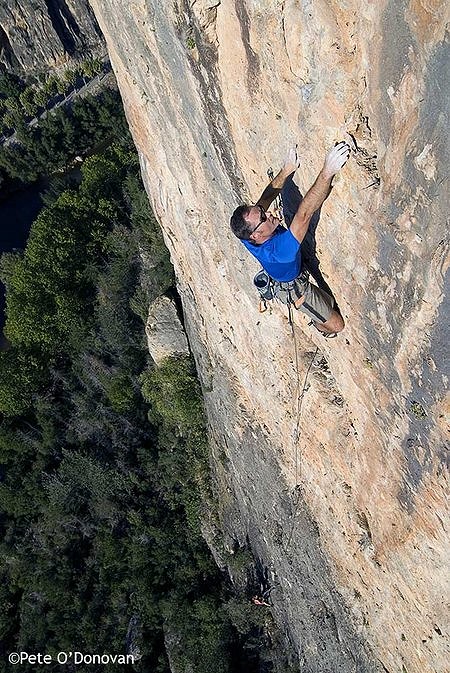
Incidentally, I'm no expert, but it has occurred to me that the presence of so many of one species of top predator (Gyps fulvus) in an area could possibly be detrimental to the prospects of other similar species sharing the same habitat? Perhaps someone more knowledgeable on the subject would care to offer an opinion?
According to my sources in Catalunya, the main instigators behind the draft proposal are a couple of high-ranking officials who apparently view climbers as only slightly higher up the social scale than drug-pushers and paedophiles. On their advice, restrictions have recently come into force in several other Catalan climbing locations — Montserrat (south side), Sadernes (an excellent though little known spot near Girona) and Montsant. If they are allowed to carry on like this half the rock in the country could soon be out of bounds. Given the numbers of foreign climbers visiting the area each year, I'd be amazed if the government just rolled over and let this go ahead, but stranger things have happened. The Catalan climbers themselves were initially supportive of the restrictions, but see these latest proposals as a total overreaction. Currently the forums are buzzing with comment, and ideas being exchanged on the best coarse of action. They will certainly not give in without a fight. I intend to do everything I possibly can to help, including making sure that all the departments of the local (Lleida) government (not just the nature conservationists) realize the importance of their part of the world to climbers.
I will report back with further developments as and when they happen. In the meantime any comments, supportive or otherwise, would be gratefully received.
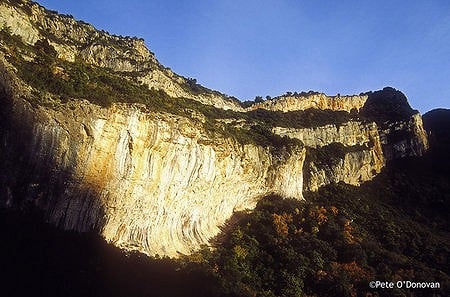

Comments